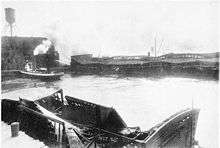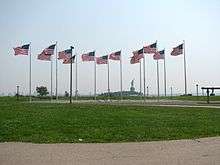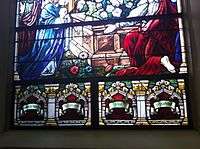Black Tom explosion
| Black Tom explosion | |
|---|---|
 Black Tom pier shortly after the explosion | |
| Location | Jersey City, New Jersey, USA |
| Coordinates | 40°41′32″N 074°03′20″W / 40.69222°N 74.05556°WCoordinates: 40°41′32″N 074°03′20″W / 40.69222°N 74.05556°W |
| Date |
July 30, 1916 2:08:00 a.m. (EST; GMT−5) |
Attack type | Sabotage |
| Deaths | 7 |
| Perpetrators | Imperial German agents |
The Black Tom explosion on July 30, 1916, in Jersey City, New Jersey, was an act of sabotage by German agents to destroy American-made munitions that were to be supplied to the Allies in World War I.[1] This incident, which happened prior to formal American entry into the war, is also notable for causing damage to the Statue of Liberty.
Black Tom Island
The term "Black Tom" originally referred to an island in New York Harbor next to Liberty Island. The island received its name from an early black resident. By 1880, a causeway and railroad had been built to connect it with the mainland to use as a shipping depot.[2] Between 1905 and 1916, the Lehigh Valley Railroad, which owned the island and causeway, expanded the island with landfill, and the entire area was annexed by Jersey City. A mile-long pier on the island housed a depot and warehouses for the National Dock and Storage Company.
Black Tom was a major munitions depot for the northeastern United States. Until early 1915, American munitions companies could sell to any buyer. After the Blockade of Germany by the Royal Navy, however, only the Allied powers could purchase from them. As a result, Imperial Germany sent secret agents to the United States to obstruct the production and delivery of war munitions that were intended to be used by its enemies.
On the night of the attack, about 2,000,000 lb (1000 tons) of small arms and artillery ammunition were stored at the depot in freight cars and on barges, including 100,000 pounds of TNT on the Johnson Barge No. 17. All was waiting to be shipped to Britain and France. Jersey City's Commissioner of Public Safety, Frank Hague, later said he had been told the barge was "tied up at Black Tom to avoid a twenty-five dollar towing charge."[3]
Explosion


After midnight on July 30, a series of small fires were discovered on the pier. Some guards fled, fearing an explosion. Others attempted to fight the fires and eventually called the Jersey City Fire Department.
At 2:08 a.m., the first and largest of the explosions took place. Fragments from the explosion traveled long distances, some lodging in the Statue of Liberty and some in the clock tower of The Jersey Journal building in Journal Square, over a mile away, stopping the clock at 2:12 a.m. The explosion was the equivalent of an earthquake measuring between 5.0 and 5.5 on the Richter scale[3] and was felt as far away as Philadelphia. Windows were broken as far as 25 miles (40 km) away, including thousands in lower Manhattan. Some window panes in Times Square were shattered. The stained glass windows in St. Patrick's Church were destroyed.[4] The outer wall of Jersey City's City Hall was cracked and the Brooklyn Bridge was shaken. People as far away as Maryland were awakened by what they thought was an earthquake.
Property damage from the attack was estimated at $20 million ($445,000,000 in 2014 dollars using the CPI conversion). The damage to the Statue of Liberty was estimated to be $100,000 ($2,225,000 in 2014 dollars using the CPI conversion), and included damage to the skirt and torch.[5]
Immigrants being processed at Ellis Island had to be evacuated to lower Manhattan. Seven[6] people died in the attack, including a Jersey City policeman,[7][8] a Lehigh Valley Railroad Chief Of Police,[9] a ten-week-old infant,[8] and the barge captain.[8] Injuries numbered in the hundreds. Smaller explosions continued to occur for hours after the initial blast.
Investigation
Two of the watchmen who had lit smudge pots to keep away mosquitoes on their watch were immediately arrested. It soon became clear that the smudge pots had not caused the fire and that the blast had not been an accident.
Many years later, the explosion was traced to Michael Kristoff, a Slovak immigrant. Kristoff had served in the US Army in World War I, but admitted to working for German agents (transporting suitcases) in 1915 and 1916 while the US was still neutral. According to Kristoff, two of the guards at Black Tom were German agents. It is likely that the bombing involved some of the techniques developed by German agents working for German ambassador Count Johann Heinrich von Bernstorff, using the cigar bombs developed by Doctor Walter Scheele.[10] Suspicion at the time fell solely on German saboteurs such as Kurt Jahnke and his assistant Lothar Witzke, who are still judged as legally responsible.[11] Later investigations in the aftermath of the Annie Larsen affair unearthed links between the Ghadar conspiracy and the Black Tom explosion.
Additional investigations by the Directorate of Naval Intelligence also found links to some members of the Irish "Clan na Gael" group, the Indian "Ghadar Party" and Communist elements.[12][13] The Irish socialist James Larkin asserted that he had not participated in active sabotage but had encouraged work slowing and strikes for higher wages and better conditions, in an affidavit to McCloy in 1934.[14][15]
The Statue of Liberty's torch has been closed to the public since the explosion.[16] "A hundred years ago you could climb a precarious ladder in her arm to enjoy the view from the torch. That practice was ended because of the Black Tom explosion."[17]
The Lehigh Valley Railroad, advised by John J. McCloy, sought damages against Germany under the Treaty of Berlin from the German-American Mixed Claims Commission. The commission declared in 1939 that Imperial Germany had been responsible and ordered damages. The two sides finally settled on $50 million in 1953. The final payment was made in 1979.
Legacy
Landfill projects later made Black Tom Island part of the mainland, and it was incorporated into Liberty State Park. The former Black Tom Island is at the end of Morris Pesin Drive in the southeastern corner of the park, where a plaque marks the spot of the explosion. A circle of American flags complements the plaque, which stands east of the visitors' center.
The inscription on the plaque reads:
Explosion at Liberty!
On July 30, 1916 the Black Tom munitions depot exploded rocking New York Harbor and sending residents tumbling from their beds.
The noise of the explosion was heard as far away as Maryland and Connecticut. On Ellis Island, terrified immigrants were evacuated by ferry to the Battery. Shrapnel pierced the Statue of Liberty (the arm of the Statue was closed to visitors after this). Property damage was estimated at $20 million. It is not known how many died.
Why the explosion? Was it an accident or planned? According to historians, the Germans sabotaged the Lehigh Valley munitions depot in order to stop deliveries being made to the British who had blockaded the Germans in Europe.
You are walking on a site which saw one of the worst acts of terrorism in American history.
A stained glass window at Our Lady of Czestochowa Catholic church memorialized the victims of the attack.[18]
-
Melted bottle from the Black Tom explosion
-

Commemorative plaque
-

Stained glass windows from inside Our Lady of Czestochowa Catholic Church in Jersey City, NJ. The bottom stained-glass windows have text in Polish to commemorate the explosion in 1916.
See also
- Anton Dilger
- Largest artificial non-nuclear explosions
- List of accidents and incidents involving transport or storage of ammunition
- United States in World War I
- Zimmermann Telegram
Notes
- ↑ "A Byte out of FBI history". Federal Bureau of Investigation. July 30, 2004. Retrieved July 5, 2009.
- ↑ "THE POINT OF ROCKS LINE More about the Little Railroad". New York Times. September 8, 1879.
- 1 2 "Black Tom Explosion (1916)". state.nj.gov. January 26, 2005. Retrieved July 5, 2009.
- ↑ Capo, Fran (2004). "Terrorist Attack Blamed on Mosquitoes". It happened in New Jersey. Guilford, Conn.: Twodot. p. 106. ISBN 0762723580.
- ↑ Frank Warner (July 4, 2009). "When Liberty trembled". The Morning Call. Retrieved July 4, 2009.
- ↑ Eugene Register-Guard July 31, 1916 gives total as 4 killed; 3 mortally injured; 35 seriously injured and 11-20 "missing"
- ↑ "The Officer Down Memorial Page Remembers". The Officer Down Memorial Page. 2009. Retrieved July 5, 2009.
- 1 2 3 Carmela Karnoutsos (2009). "Black Tom Explosion". New Jersey City University. Retrieved July 5, 2009.
- ↑ "The Officer Down Memorial Page Remembers". The Officer Down Memorial Page. 2009. Retrieved July 5, 2009.
- ↑ H. R. Balkhage and A. A. Hahling (August 1964). "The Black Tom Explosion". The American Legion Magazine. Retrieved July 5, 2009.
- ↑ World War I Encyclopedia. Volume 4 S–Z. Edited by Spencer Tucker, p. 1033.
- ↑ Stafford, D. "Men of Secrets: Teddy Roosevelt and Winston Churchill". New York Times. Retrieved 2007-10-24.
- ↑ Moynihan, D.P. "Report of the Commission on Protecting and Reducing Government Secrecy. Senate Document 105-2". Fas.org. Retrieved 2007-10-24.
- ↑ Millman, C. The Detonators: The Secret Plot to Destroy America and an Epic Hunt for Justice (New York: Little, Brown, 2006) ISBN 978-0-316-73496-7.
- ↑ Review of Millman's book in The New York Observer, 16 July 2006. Archived January 23, 2011, at the Wayback Machine.
- ↑ NPS: Statue of Liberty|FAQs
- ↑ Long, John. 2016. "Terrorism's 100th Anniversary". Roanoke Times. July 28, 2016. Page 7.
- ↑ Pyle, Richard (July 30, 2006). "1916 Black Tom Blast Anniversary Observed". The Washington Post. Retrieved February 1, 2011.
References
- Long, John. 2016. "Terrorism's 100th Anniversary". Roanoke Times. July 28, 2016. Page 7.
- Chad Millman. The Detonators: The Secret Plot to Destroy America and an Epic Hunt for Justice (July 12, 2006 ed.). Little, Brown and Company. p. 352. ISBN 0-316-73496-9.
- Jules Witcover. Sabotage at Black Tom: Imperial Germany's Secret in America, 1914–1917 (May 1989 ed.). Algonquin Books; First Edition/First Printing edition. p. 339. ISBN 0-912697-98-9.
- Ron Semple, Black Tom: Terror on the Hudson (October 30, 2015) Top Hat Books, p. 514. ISBN 978-1-78535-110-5
External links
| Wikimedia Commons has media related to Black Tom explosion. |
- Black Tom explosion New Jersey Park webpage
- American Legion 1964
- New Jersey City University article on the Black Tom explosion. Includes photos.
- View footage of the Black Tom Island incident in 1916